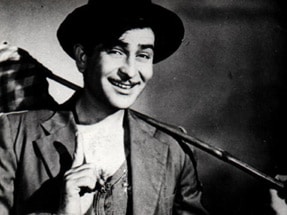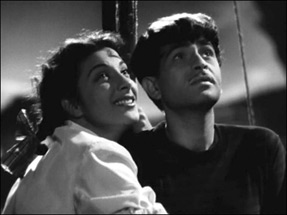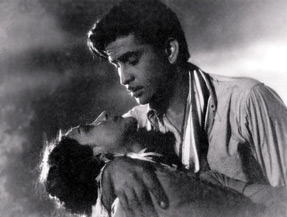|
Raj Kapoor was different things to different people.
To some, he was the greatest showman Indian Cinema had ever seen. Mr.
Razzle-Dazzle who converted the simplest of occasions — Mahurats, Holy
celebrations, parties — into major events. The last of the movie moguls who
truly thought big — big budgets, big canvas, and of course, big women!
To some, he was Hindi cinema’s most passionate champion; a dedicated
and creative filmmaker who genuinely loved the medium, giving his all to the
industry.
To some, he was one of the legendary trio — the other two being Dev
Anand and Dilip Kumar — who formed the triumvirate that dominated the screen of
the 1950s and 1960s.
To some, he was the smartie who localized the “Chaplin” hero to give us
“Raju” — the evergreen, happy-go-lucky tramp — the charming and zany Awara and 420 who took the 1950s by storm, striking as much by his comic antics, his
passionate romancing with his first (and greatest) R. K. heroine, Nargis, as
also his strong social cinematic comment.
To some, he was the eternal optimist, the resilient, ne’er-say-die war
horse, who was sometimes down, but never out. The ambitious, flamboyant
gambler, who staked everything in what he believed — and to hell with current
vogues!
Interestingly, the legend started small. The eldest son of the late
Prithviraj Kapoor — a Pathan from Peshawar, stunningly built and spectacular
looking, who abandoned a career in law for the magic of the screen and stage —
Raj Kapoor’s first job was that of a clapper boy in a Kedar Sharma film in
1942. Hired by Ranjit Movietone at the princely sum of Rs 10 a month, Raj
occasionally managed an extra rupee bonus whenever he was lucky enough to be
selected as an “extra.” Bombay Talkies was his next stop. The money was better
— Rs. 100 a month — but the queen who reigned over that studio, Devika Rani,
wasn’t impressed. This rankled all the more when her eyes repeatedly sought out
another aspirant for special attention. Name? Yusuf Khan — alias Dilip Kumar!
Rumor has it that when Raj, after a year of steady “iceberg” treatment, finally
approached the great lady for a job, she promptly fired him!
 |
It was this humilation, believe Raj–watchers, that could well have
propelled the blue-eyed Kapoor to do his own thing. At 21, he produced and
acted in Aag. A modest success, he next made Barsaat, which rocketed him into big time. Teaming with Nargis, this film set
the tone for the R.K. movies and established a team of outstanding
professionals — Shanker-Jaikishen, Lata Mangeshkar, Mukesh, Shailendra, Hasrat
— without peer. And then came Awara, a father-son story scripted by
K.A. Abbas, with Prithviraj Kapoor and Raj Kapoor in mind. Mehboob Khan
reportedly showed interest when offered the project, but insisted on replacing
Raj with Dilip. He bought the script, allowed Abbas to sweet-talk a reluctant
Prithviraj into playing his father, and started rolling. A super smash in every
department — music, photography, acting, direction — Awara marked the beginning of a long and successful association with Abbas
which was to run its course through three decades to Bobby (1973). Awara also marked the beginning of Raj’s “Chaplinesque” phase: the funny
walk, the blend of effervescent humor, romantic pathos, rib-tickling slapstick,
the telling idealism — it was all there, desified. It was Awara that blazed his stars in the Soviet Union and Eastern Europe, regions
where even today he remains a folk-hero. “Mein Awara Hoon” and “Mera
Joota Hai Japani” continue to be signature tunes as far as
Indian music goes for millions in that part of the globe, with Shree 420 (among others) further perpetuating this image.
With the 1960s, came a change in focus. Romance gave way to flash,
sensuousness gave way to blatant sex-appeal. And the R.K. masterpieces of the
1950s, with the exquisite Nargis as centre-piece, were gently soft-focused from
sight to memory making way for films like Jis Desh Mein Ganga Behti Hain with the heavy-hipped and bosomy Padmini. Now it was all super
packaging. “Style” was the thing — not “substance.”
Jis Desh, a huge grosser, was followed by the spectacular Sangam, the first Hindi film shot extensively abroad, setting a trend which
other film-makers in herd-fashion followed. A smash hit, it paved the way for
the most ambitious film of his life — Mera Naam Joker, a five-hour epic that attempted to document the joys and sorrows of a
circus clown.
A spectacular flop (“too diverse a theme,” according to industry
critics, “Too old fashioned, his kind of films are outdated”) he made Bobby, a love story with two newcomers, his son Rishi Kapoor and Dimple
Kapadia. At a time when “multi-starrers” and “action” films were running into
their own, Bobby appeared to be a very risky business proposition, completely out of
sync with every conceivable formula ruling the roost — but Raj was undaunted.
“Love can never date” declared its most passionate apostle. It proved to be one
of the biggest megahits of its time — and Raj had struck again! Critics panned
it, but as Raj caustically claimed, “Had it bombed, they would have called it a
classic.”
 |
His next was his most controversial film ever Satyam Shivam
Sundaram. Demolishing all accepted Indian film
norms by permitting kissing on the screen, he had a scantily clad Zeenat Aman —
the industry’s celebrated non-actress with a beautiful body — bouncing through
the footage. Wanting to educate the Indian public to accept nudity as an art
form, Kapoor obviously was hoping for a format to attract commercial viability
— in vain. Prem
Rog came next, with love as the central theme. Successful
as it was, the film was a far cry from the maker of Awara, Barsaat and Shree
420. His last film, Ram Teri Ganga Maili starring his youngest son, Rajiv Kapoor and a newcomer named Mandakini
as heroine, set the box-office on fire. On cue, it bared its young nubile
heroine’s ample assets like never before, only propagating Kapoor’s personal
vision of erotica as a thing of beauty, “For better or worse, I have been
accused of stripping my heroines. Beauty, like evil, is in the eyes of the
beholder, and where I see beauty, others see evil.”
In the final analysis, whatever the failings of Raj Kapoor, one thing
remains certain: he was truly India’s greatest showman! A gutsy up-front
filmmaker who continuously braved odds and defied the times to weave his own
personal version of aching, heart-stopping, romantic fare. Repeatedly reminding
a blasé and cynical world that when the last of the gimmicks, formula and
combinations will have bitten the dust, one thing will remain ever-true,
evergreen and ever- fresh……. love |






You must be logged in to post a comment Login